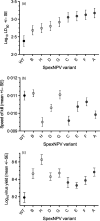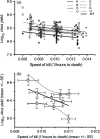Trade-offs and mixed infections in an obligate-killing insect pathogen
- PMID: 27155461
- PMCID: PMC4988505
- DOI: 10.1111/1365-2656.12547
Trade-offs and mixed infections in an obligate-killing insect pathogen
Abstract
Natural populations of pathogens are frequently composed of numerous interacting strains. Understanding what maintains this diversity remains a key focus of research in disease ecology. In addition, within-host pathogen dynamics can have a strong impact on both infection outcome and the evolution of pathogen virulence, and thus, understanding the impact of pathogen diversity is important for disease management. We compared eight genetically distinguishable variants from Spodoptera exempta nucleopolyhedrovirus (SpexNPV) isolated from the African armyworm, Spodoptera exempta. NPVs are obligate killers, and the vast majority of transmission stages are not released until after the host has died. The NPV variants differed significantly in their virulence and could be clustered into two groups based on their dose-response curves. They also differed in their speed of kill and productivity (transmission potential) for S. exempta. The mixed-genotype wild-type (WT) SpexNPV, from which each variant was isolated, was significantly more virulent than any individual variant and its mean mortality rate was within the fastest group of individual variants. However, the WT virus produced fewer new infectious stages than any single variant, which might reflect competition among the variants. A survival analysis, combining the mortality and speed of kill data, confirmed the superiority of the genetically mixed WT virus over any single variant. Spodoptera exempta larvae infected with WT SpexNPV were predicted to die 2·7 and 1·9 times faster than insects infected with isolates from either of the two clusters of genotypes. Theory suggests that there are likely to be trade-offs between pathogen fitness traits. Across all larvae, there was a negative linear relationship between virus yield and speed of kill, such that more rapid host death carried the cost of producing fewer transmission stages. We also found a near-significant relationship for the same trend at the intervariant level. However, there was no evidence for a significant relationship between the induced level of mortality and transmission potential (virus yield) or speed of kill.
Keywords: dose-response; entomopathogen; infection diversity; mortality rate; polymorphism; transmission potential; virulence.
© 2016 The Authors. Journal of Animal Ecology published by John Wiley & Sons Ltd on behalf of British Ecological Society.
Figures



 , B
, B  , C
, C  , D
, D  , E
, E  , F
, F  , G
, G  , H
, H  and
and  ) and (b) intergenotype level. In (b), mean speed of kill was estimated only using larvae for which virus yield data were also available.
) and (b) intergenotype level. In (b), mean speed of kill was estimated only using larvae for which virus yield data were also available.References
-
- Alizon, S. , de Roode, J.C. & Michalakis, J. (2013) Multiple infections and the evolution of virulence. Ecology Letters, 16, 556–567. - PubMed
-
- Alizon, S. , Hurford, A. , Mideo, N. & Van Baalen, M. (2009) Virulence evolution and the trade‐off hypothesis: history, current state of affairs and the future. Journal of Evolutionary Biology, 22, 245–259. - PubMed
-
- Andre, J.B. & Hochberg, M.E. (2005) Virulence evolution in emerging infectious diseases. Evolution, 59, 1406–1412. - PubMed
-
- Balmer, O. & Tanner, M. (2011) Prevalence and implications of multiple‐strain infections. The Lancet Infectious Diseases, 11, 868–978. - PubMed
MeSH terms
Associated data
Grants and funding
LinkOut - more resources
Full Text Sources
Other Literature Sources

